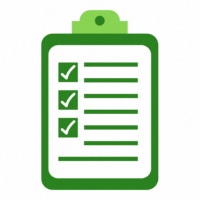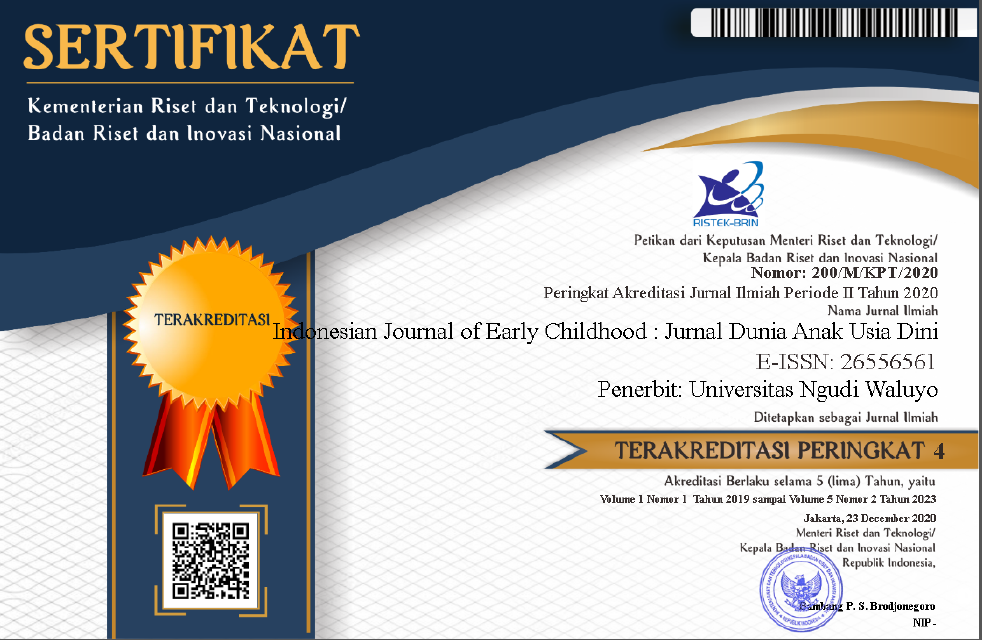Media Loose Parts dalam Menstimulasi Keaksaraan Awal Anak Kelompok A di TK Baik Krapyak
Loose Parts Media in Stimulating Early Literacy Group A Children in Kindergarten Baik Krapyak
DOI:
https://doi.org/10.35473/ijec.v7i1.3182Abstract
Early childhood learning activities have the principle of learning while playing. The play tools used are usually real so that you can learn about shape, size, color, and so on. One media that can support children's early literacy stimulation is loose parts media. Loosaparta is a natural, used or artificial material that can be combined from one material with another, so that children can learn concretely. The research aims to describe looseparts media in stimulating early literacy for group A children at Kindergarten BAIK. This type of research is qualitative research with a case study approach. Data collection techniques were obtained from classes Al and A2 by observing learning activities, interviews and documentation. Checking the validity of the data was carried out using the triangulation techniquel. The results of the research show that looseparts stimulates early literacy in group A children at Kindergarten BAIK by carrying out all stages of using looseparts. The first stage of the teacher is edukası (conveying the topic) the child is in the exploration stage (exploringı) The second stage of the teacher is expansion (invitation and provocation) the second stage of the child is experimentation (trying out), the third stage of the child is creative (exploring the material) the teacher is in development stage (documentation), the fourth stage is carried out by children together with the teacher, namely building the meaning and purpose of play (reviewing).
ABSTRAK
Kegiatan belajar anak usia dini memiliki prinsip belajar sambil bermain. Alat permainan yang digunakan biasanya berbentuk nyata sehingga dapat belajar mengenai bentuk, ukuran, warna, dan sebagainya. Salah satu media yang dapat mendukung untuk menstimulasi keaksaraan awal anak adalah dengan media looseparts. Looseparts merupakan bahan alam, bekas, maupun buatan yang dapat dikombinasikan dari satu bahan dengan bahan lain, sehingga anak dapat belajar secara konkrit. Penelitian ini bertujuan untuk mendeskripsikan media looseparts dalam menstimulasi keaksaraan awal untuk anak kelompok A di TK BAIK. Jenis penelitian ini adalah penelitian kualitatif dengan pendekatan studi kasus. Teknik pengumpulan data diperoleh dari kelas A1 dan A2 dengan melakukan observasi kegiatan pembelajaran, wawancara, dan dokumentasi. Pemeriksaan keabsahan data dilakukan dengan teknik triangulasi. Hasil penelitian menunjukan bahwa looseparts dalam menstimulasi keaksaraan awal anak kelompok A di TK BAIK dilaksanakan dengan melakukan seluruh tahapan penggunaan looseparts. Tahap pertama guru adalah edukasi (menyampaikan topik) anak berada pada tahap eksplorasi (menjelajahi). Tahap kedua guru adalah ekspansi (invitasi dan provokasi) tahap kedua anak yaitu eksperimen (mencoba-coba), tahap ketiga anak yaitu kreatif (mengeksplor bahan) guru berada pada tahap perkembangan (dokumentasi), tahap keempat dilakukan anak bersama guru yaitu membangun makna dan tujuan bermain (mereview).
References
Anggraini. (2019). Stimulasi Keterampilan Menyimak terhadap Perkembangan Anak Usia Dini. Raudhatul Athfal : Jurnal Pendidikan Islam Anak Usia Dini, 30-44.
Anggraini, D. R. (2022). KEAKSARAAN AWAL PADA ANAK USIA DINI : TINJAUAN DARI SUDUT PANDANG ORANG TUA DAN PENDIDIK. as-sibyan : Jurnal Pendidikan Anak Usia Dini, 7(2), 221-234.
Barat, K. P. (2020). PANDUAN PENGELOLAAN LOOSEPARTS. Jawa Barat: Kementrian Pendidikan dan Kebudayaan PP PAUD dan Dikmas Jawa Barat.
Chairunnisa, & Masyhuri, A.A. (2019). Peningkatan Kemampuan Menulis Anak Usia Dini Dengan Menggunakan Metode Meniru Tulisan. Jurnal Pemikiran dan Penelitian Dasar, 3(1), 72-82.
Hofifah, D. A., Aisyah, D. S., & Riana, N. (2022). Peningkatan Keaksaraan pada Anak Usia 4-5 Tahun melalui Media Gambar Variasi. Jurnal Pendidikan Raudhatul Athfal, 5(1), 62-71.
Leonia, R. A., Handayani, T., & Putri, Y. F. (2022). Pengaruh Media Loose Parts Terhadap Kemampuan Pra Menulis Anak Usia Dini Pada Kelompok B di Kecamatan Tebing Tinggi. Jurnal PG-PAUD Trunojoyo, 9(2), 9-17.
Margono. (2013). Metodologi Penelitian Pendidikan. Jakarta: Rineka Cipta.
Moleong, L. J. (2017). Metodologi Penelitian Kualitatif. Bandung: Remaja Rosdakarya.
Nisa, Amal, & Nilawati (2021). Meningkatkan Kemampuan Keaksaraan Awal Melalui Kegiatan Bermain Kartu Huruf Bergambar. PROFESI KEPENDIDIKAN. 2(1), 225-234.
Novitasari, K. (2019). Penggunaan Teknologi Multimedia Pada Pembelajaran Literasi Anak Usia Dini. Jurnal Golden Age, 3(01), 50-56.
Rusandi, & Rusli, M. (2022). Merancang Penelitian Kualitatif Dasar/Deskriptif dan Studi Kasus. Al-Ubudiyah: Jurnal Pendidikan dan Studi Islam, 2(1).
Safira, T. A. (2019). Penerapan Permainan Modifikasi Tapak Gunung Untuk Mengembangkan Kemampuan Bahasa Anak Usia 4-5 Tahun di RA Mutiara Ciputat. Jurnal Pendidikan Anak Usia Dini, 3, 43-56.
Sari, A. M., & Linda, L. (2020). Sikap dan Respon Anak PAUD dalam Mengenal Metamorfosis Serangga melalui Media Animasi. Jurnal Obsesi : Jurnal Pendidikan Anak Usia Dini, 6(2), 1083-1100.
Setianingrum, S. &. (2016). Perkembangan Motorik Halus Anak Usia 3-4 Tahun di Kelompok Bermain Cendekia Kids School Madiun dan Implikasinya Pada Layanan Konseling. Jurnal CARE (Children Advisory Research and Education), 1-11.
Siantajani, Y. (2021). Loose Parts : Material Lepasan Otentik Stimulasi PAUD. Semarang: Sarang Seratus Ksara.
Sugiyono. (2013). METODE PENELITIAN KUANTITATIF, KUALITATIF, DAN R&D. Bandung: ALFABETA.
Suryana, R. R. (2022). Media Pembelajaran Anak Usia Dini. Jurnal PAUD Agapedia, 6, 49-58.
Yusri, N. (2021). Pembelajaran Anak Usia Dini Berbasis Loose Parts. Jurnal Adzkiya, 5(2), 24-39.
Downloads
Published
How to Cite
Issue
Section
License
Copyright (c) 2025 Indonesian Journal of Early Childhood: Jurnal Dunia Anak Usia Dini

This work is licensed under a Creative Commons Attribution-ShareAlike 4.0 International License.
Please find the rights and licenses in Indonesian Journal Of Early Childhood: Jurnal Dunia Anak Usia DIni. By submitting the article/manuscript of the article, the author(s) agree with this policy. No specific document sign-off is required.
1. License
The non-commercial use of the article will be governed by the Creative Commons Attribution license as currently displayed on Creative Commons Attribution-ShareAlike 4.0 International License.
2. Author(s)' Warranties
The author warrants that the article is original, written by stated author(s), has not been published before, contains no unlawful statements, does not infringe the rights of others, is subject to copyright that is vested exclusively in the author and free of any third party rights, and that any necessary written permissions to quote from other sources have been obtained by the author(s).
3. User Rights
Indonesian Journal Of Early Childhood: Jurnal Dunia Anak Usia Dini's spirit is to disseminate articles published are as free as possible. Under the Creative Commons license, Indonesian Journal Of Early Childhood: Jurnal Dunia Anak Usia Dini permits users to copy, distribute, display, and perform the work for non-commercial purposes only. Users will also need to attribute authors and Indonesian Journal Of Early Childhood: Jurnal Dunia Anak Usia Dini on distributing works in the journal and other media of publications.
4. Co-Authorship
If the article was jointly prepared by more than one author, any authors submitting the manuscript warrants that he/she has been authorized by all co-authors to be agreed on this copyright and license notice (agreement) on their behalf, and agrees to inform his/her co-authors of the terms of this policy. Indonesian Journal Of Early Childhood: Jurnal Dunia Anak Usia Dini will not be held liable for anything that may arise due to the author(s) internal dispute. Indonesian Journal Of Early Childhood: Jurnal Dunia Anak Usia Dini will only communicate with the corresponding author.
5. Miscellaneous
Indonesian Journal Of Early Childhood: Jurnal Dunia Anak Usia Dini will publish the article (or have it published) in the journal if the article’s editorial process is successfully completed. Indonesian Journal Of Early Childhood: Jurnal Dunia Anak Usia Dini's editors may modify the article to a style of punctuation, spelling, capitalization, referencing and usage that deems appropriate. The author acknowledges that the article may be published so that it will be publicly accessible and such access will be free of charge for the readers as mentioned in point 3.
Â
Every accepted manuscript should be accompanied by "Copyright Transfer Agreement" prior to the article publication.



